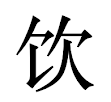Shell and Bone Script of Eat
The top looks like a hat, representing a person opening their mouth. Below is the food and the vessel containing it. This signifies a person opening their mouth to eat food.
Bronze Script of Eat
The top is similar to the Shell and Bone Script, but the bottom is a bit askew, especially the base, which should be flat but has become uneven and unstable. This could be due to the rough casting techniques of the time, distorting the originally symmetrical strokes.
Small Seal Script of Eat
It closely resembles the Bronze Script. The middle and upper parts are still fine, but the bottom, possibly following the Bronze Script, looks like animal legs rather than the base of a vessel, which is a bit confusing. This might be because the bottom of the Bronze Script was asym
Clerical Script of Eat
It continues to deviate from the original pictograph. The mouth is still present, but the two legs at the bottom have become a short and long slanted cross, completely losing the original imagery of food and vessels from the Shell and Bone Script. No one would recognize it as related to food or vessels.
Now let's discuss the character Drink
Shell and Bone Script of Drink
The bottom left part is a vessel, with the middle "口" representing soup or wine. The round hat-like shape above is an open mouth, and on the right is a person bending down to drink from the vessel.
Bronze Script of Drink
The top left part is an open mouth, with a wine jar below it. The right side shows a person holding the wine jar and drinking, with the semicircle representing the head and the dot inside likely indicating the tongue.
Small Seal Script of Drink
Similar to the Bronze Script, but the right side is simplified. The open mouth no longer has the dot, but the meaning is retained.
Clerical Script of Drink
The left side has transformed, with the original wine jar turning into the character "食"(Eat). In ancient times, "食" also had the meaning of drinking, so the character evolved from a pictograph to a compound ideogram. The right side follows the Small Seal Script, with the top part representing the head and the bottom part the body.
Let's look at the Great Seal Script of Owe.
Big Seal Script of Owe
The top part is a large open mouth, and the bottom part is the body. "欠" means to yawn. The Great Seal Script of "欠" closely resembles the right side of the Bronze Script for "飲" and somewhat resembles the Small Seal Script. Hence, the right side of the Small Seal Script for "飲" was written as "欠", where the large open mouth signifies drinking, not yawning.
The clerical script of Owe
Same as the right part of clerical script of Owe -飲.














No comments:
Post a Comment